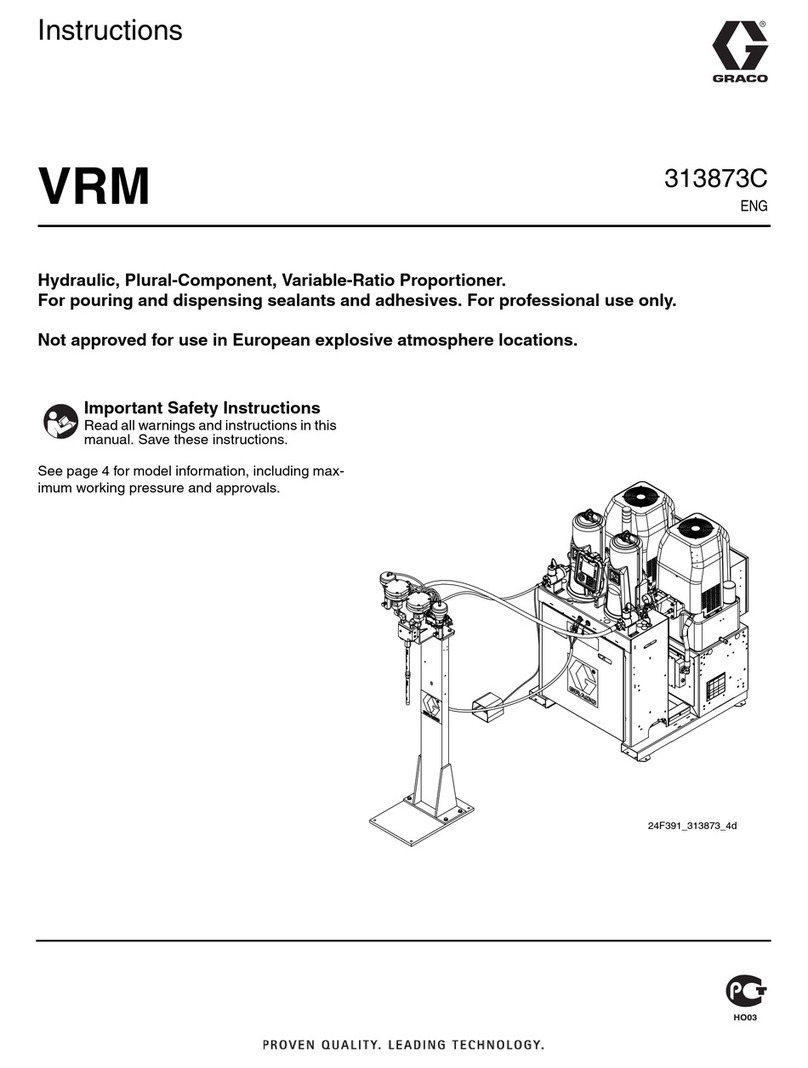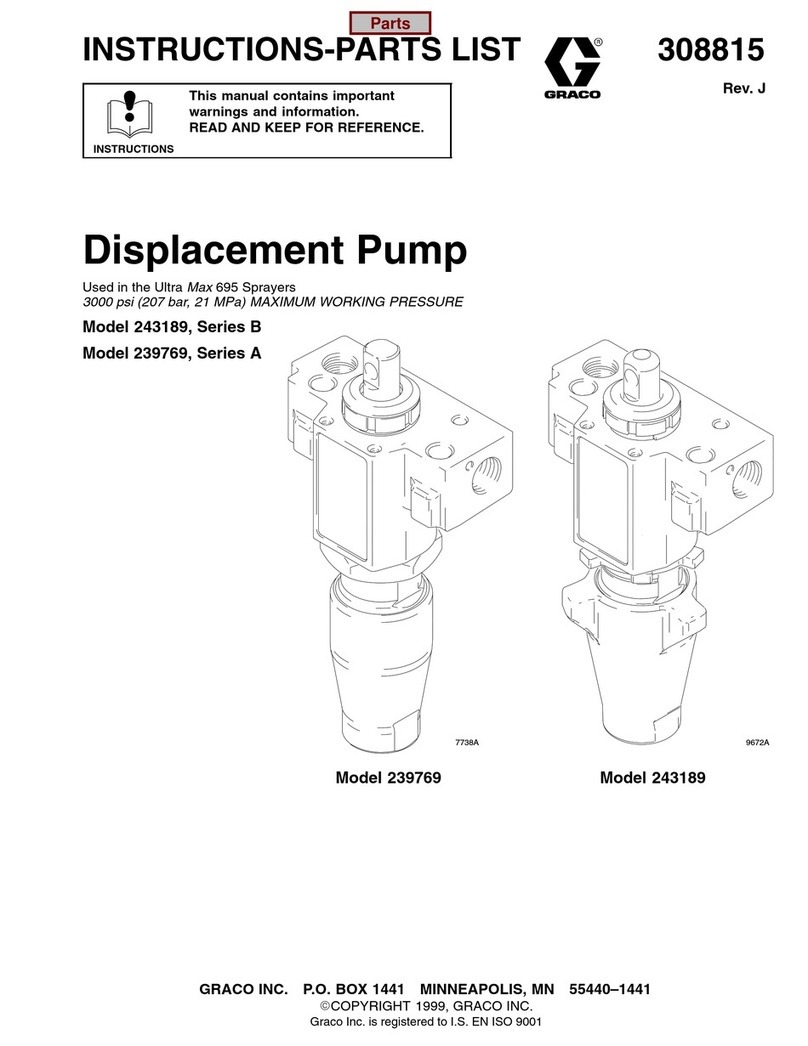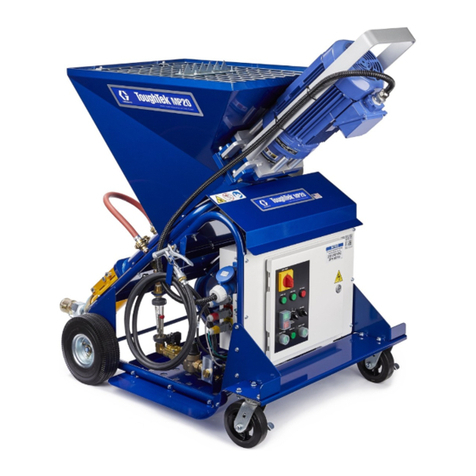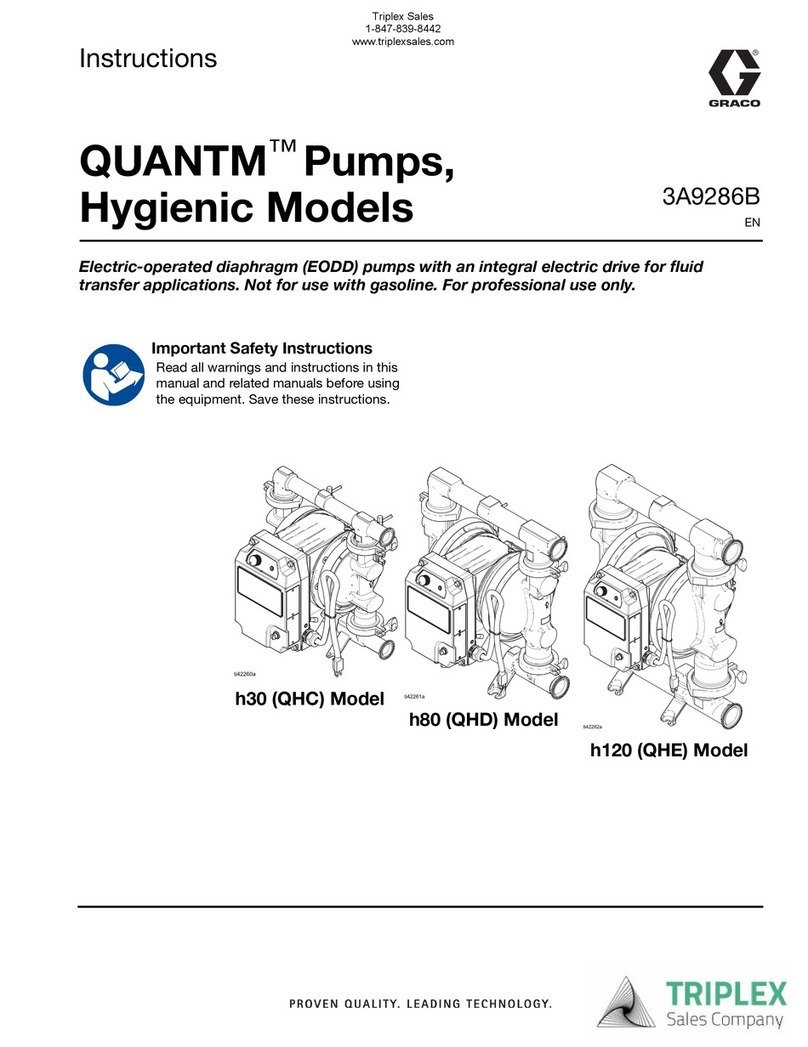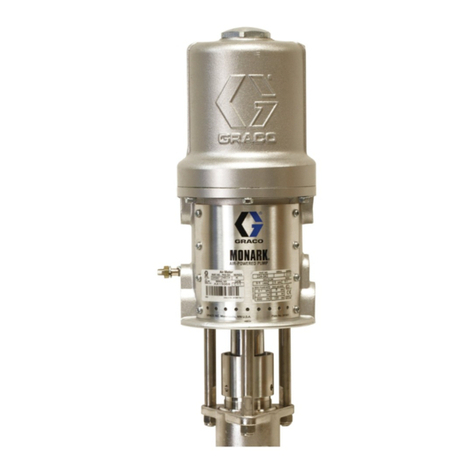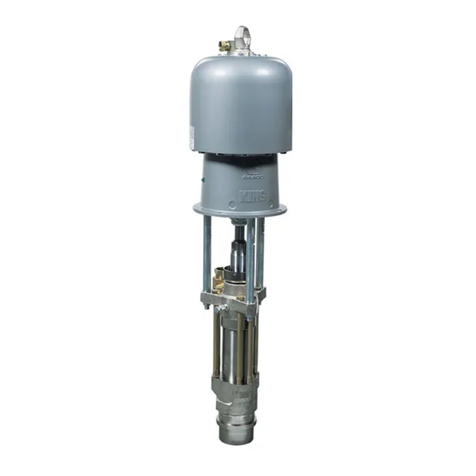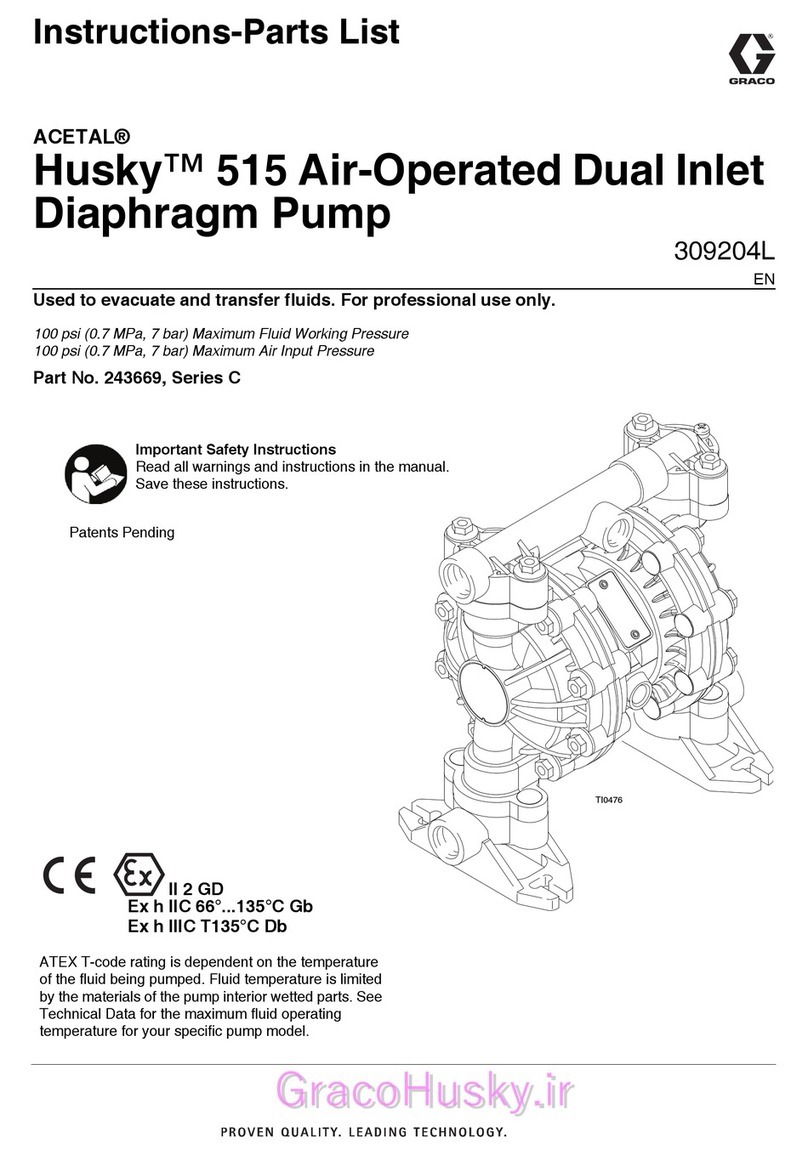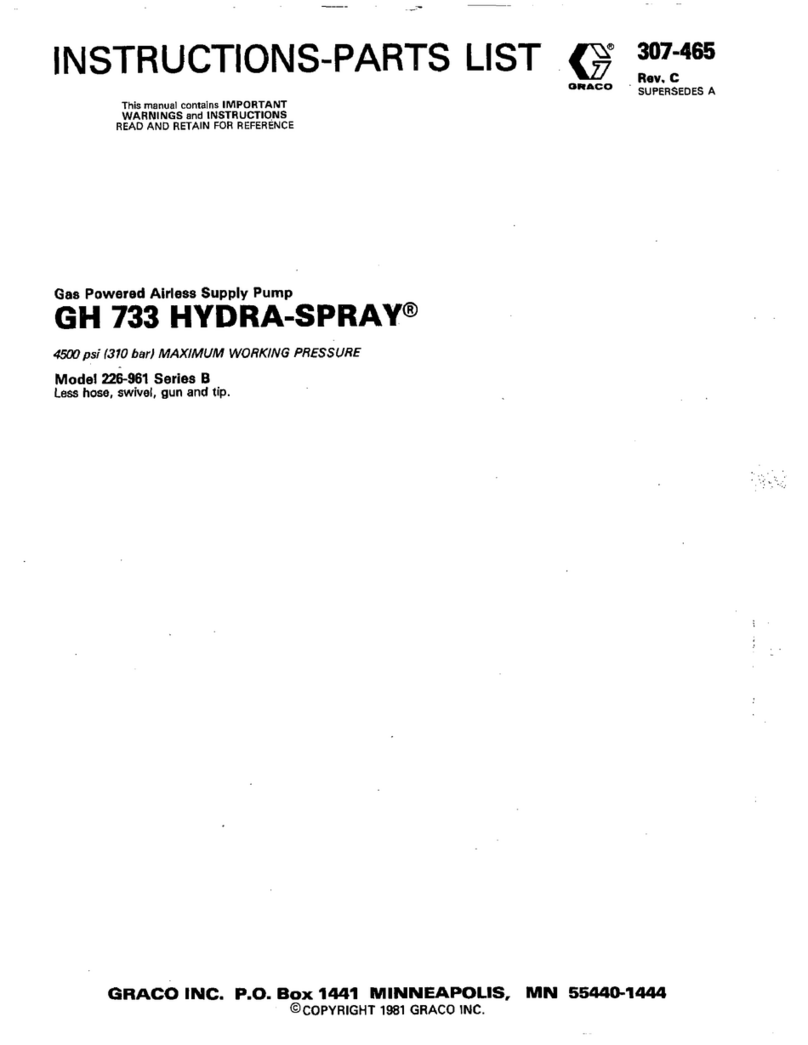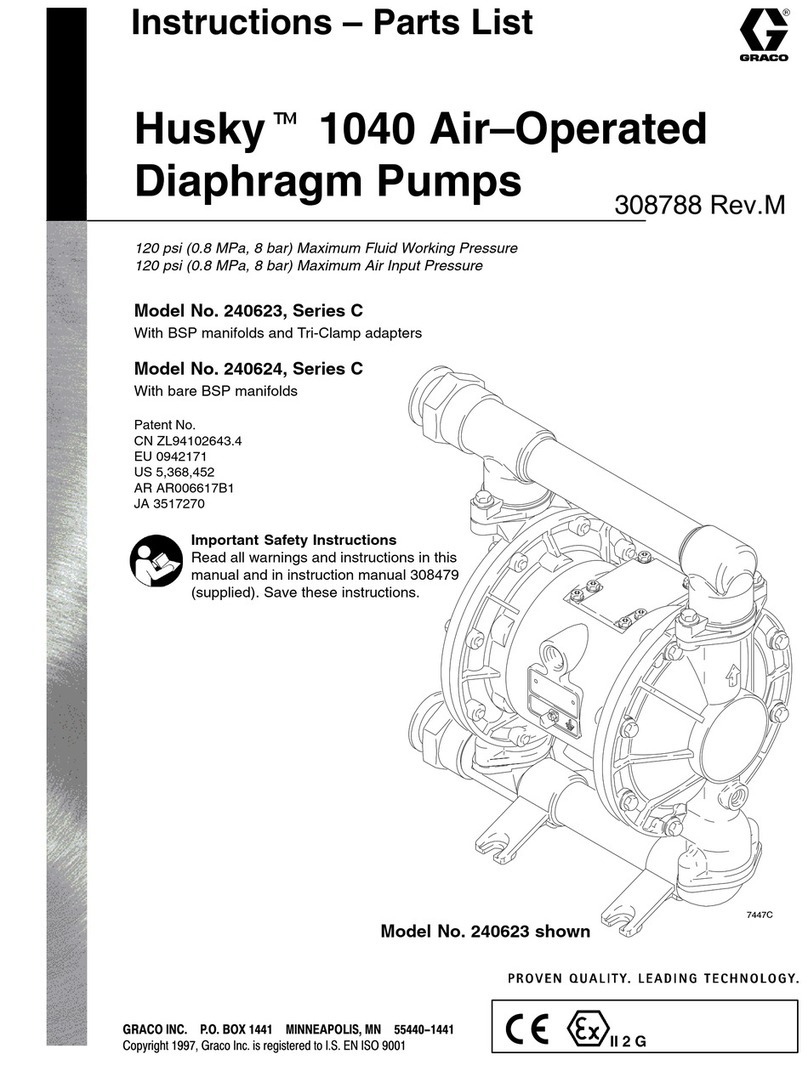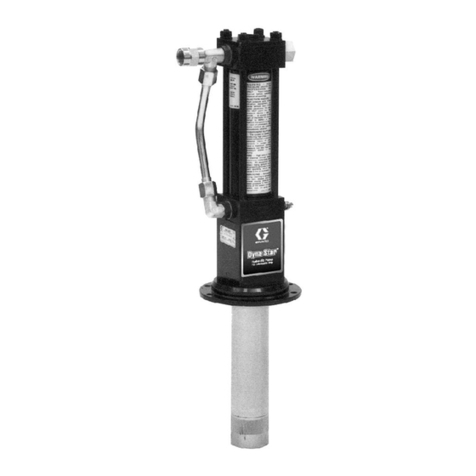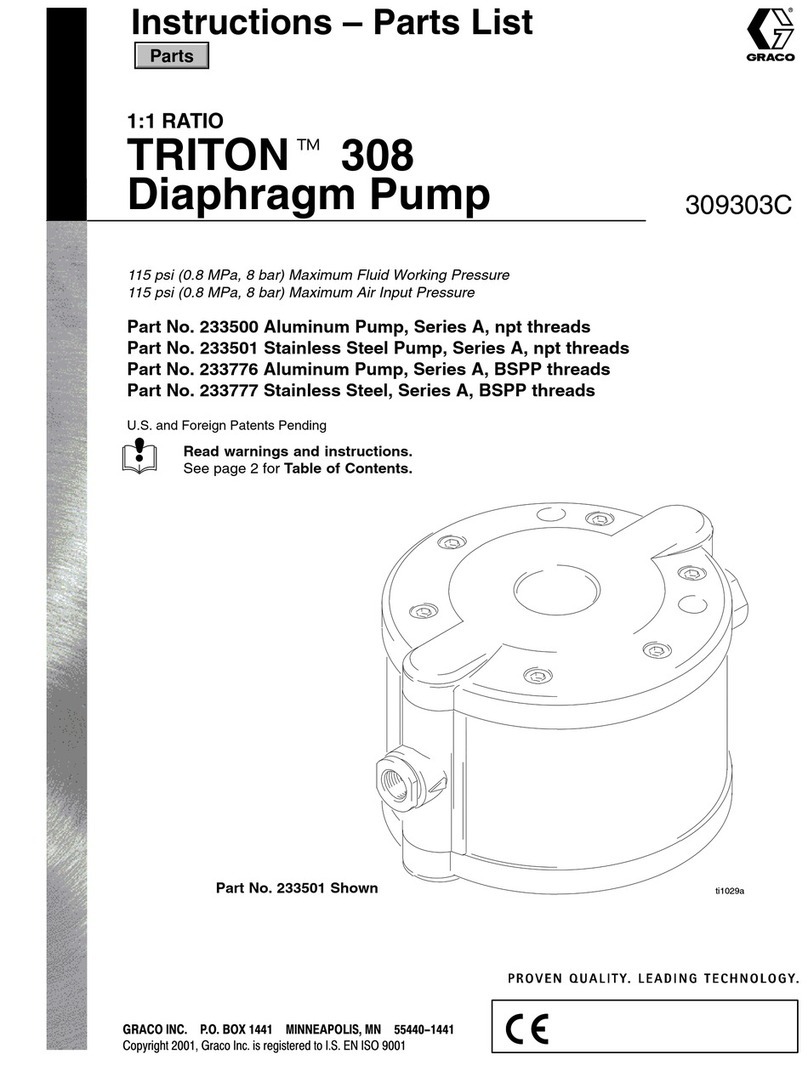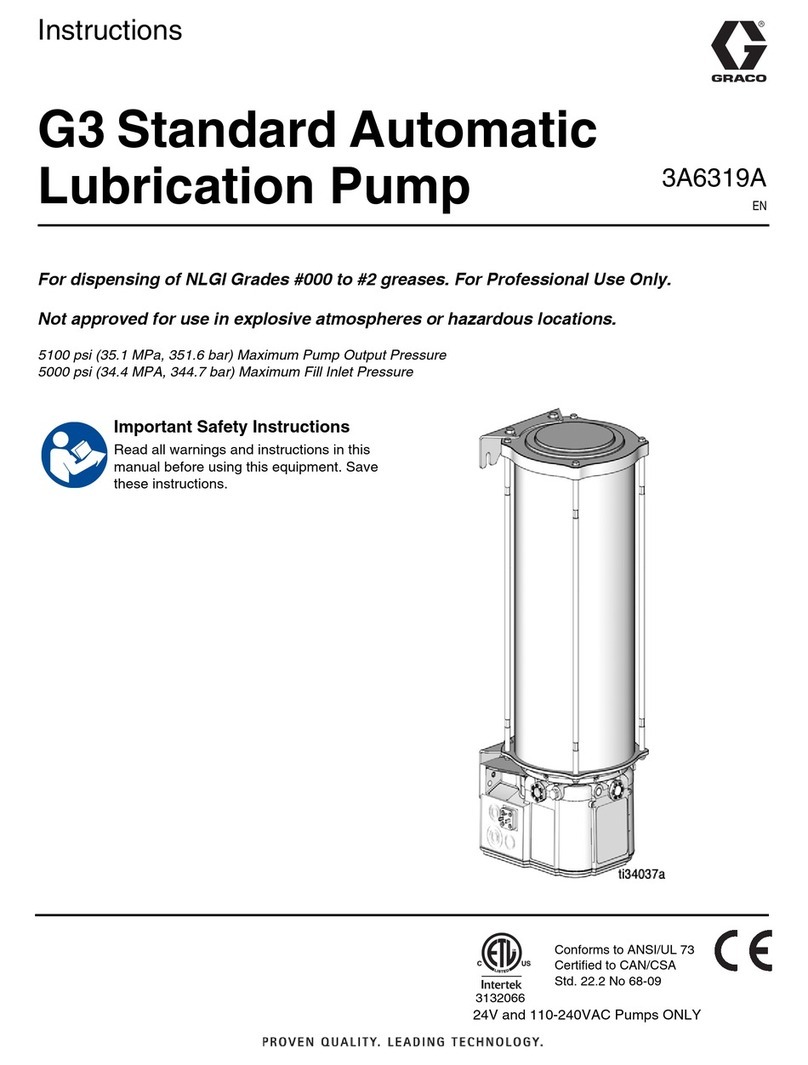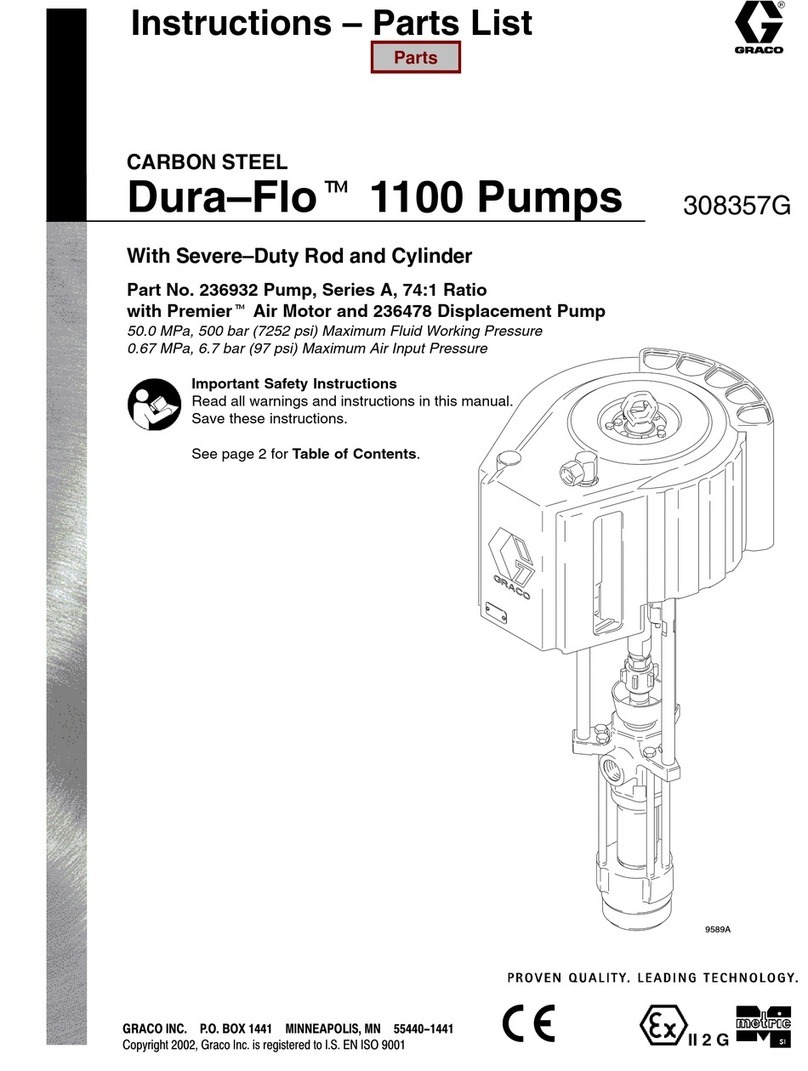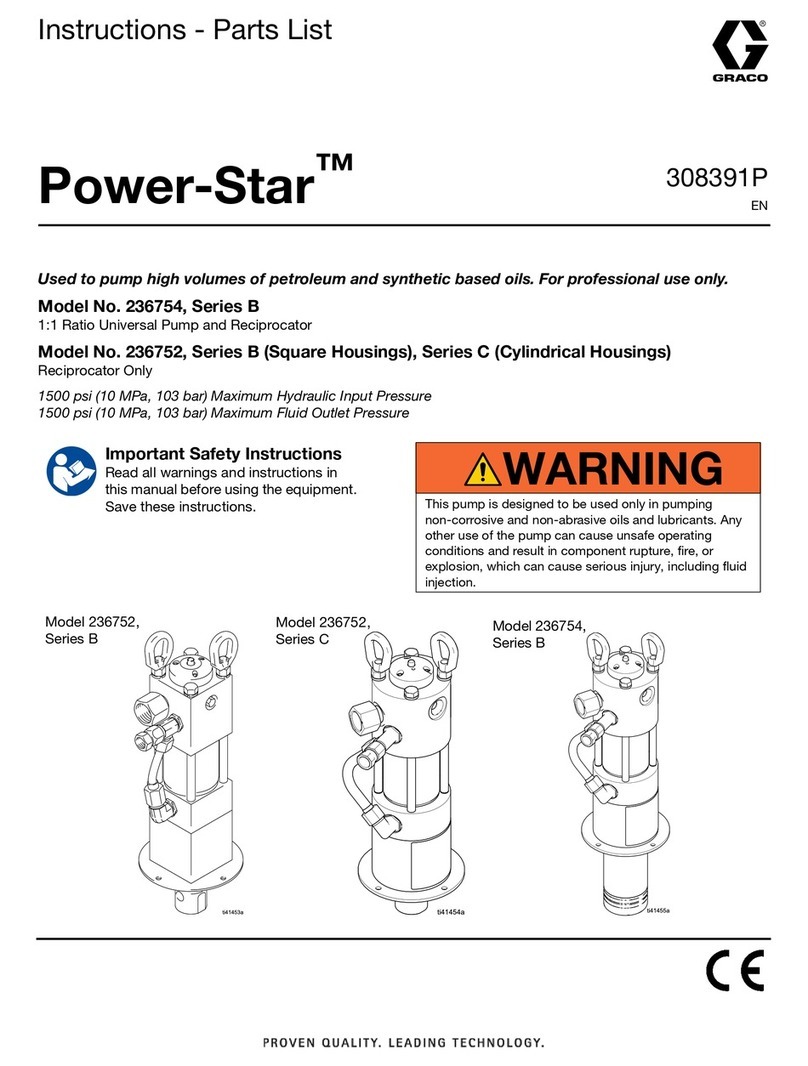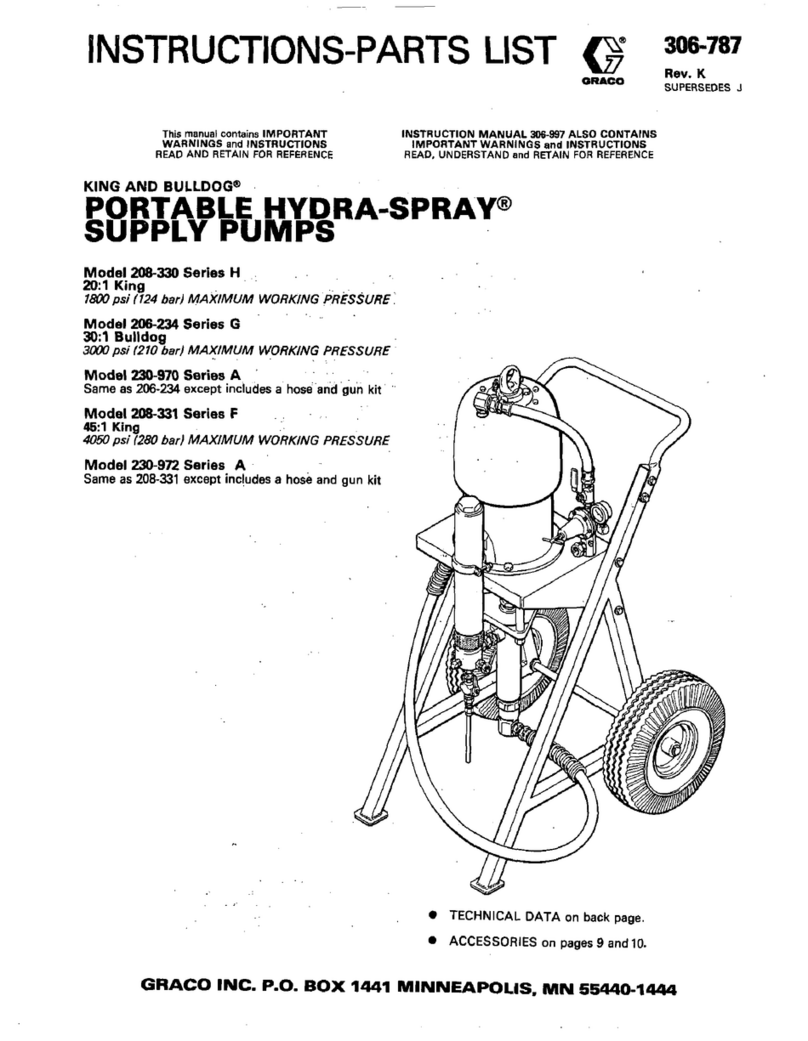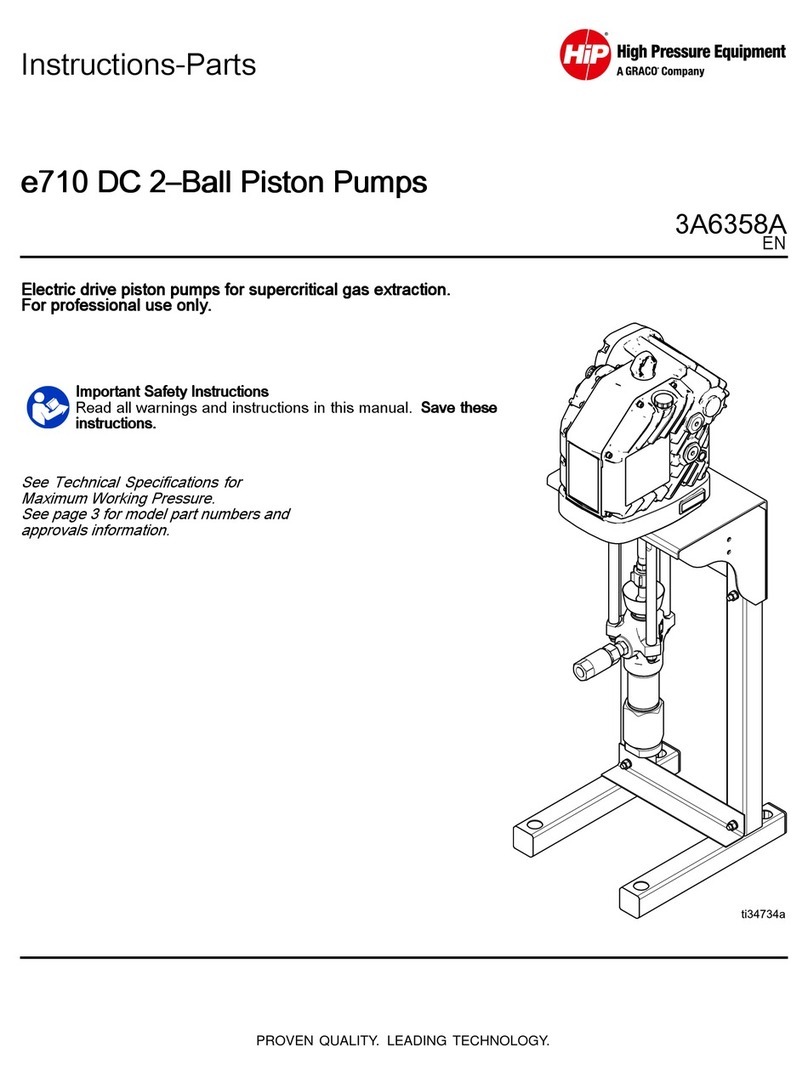
5
INSTALLATION
NOTE: The
T
ypical Installation on page 4 is
only a guide
to selecting and installing system components.
Your installation will depend on the type of fluid
being
pumped and your application needs. Con
-
tact
your Graco distributor for system design
as
-
sistance.
The
accessories mentioned in the text are avail
-
able
from Graco. See page 20.
Reference numbers and letters in parentheses
in
the text refer to the callouts on the drawings.
Mount the pump to suit the type of installation planned.
Be
sure the pump is securely bolted to its mounting.
If mounting the pump
on a wall, you must reposition the
legs so the pump will be upright. Remove the long bolts
(3, or 55 on models), nuts (15) and washers (16)
holding
the legs (12, 13) in place. Remove two short bolts
(14, or 3 on models), nuts (15) and washers (16)
from
each diaphragm cover (1
1).
Align
the legs with these vacant holes and reinstall using
the long bolts, washers, and nuts. Reinstall the short
bolts in the holes vacated by the legs. T orque the bolts
oppositely
and evenly
, to 13.5–16 N.m (9.8–12 ft–lb).
On
models, torque the long bolts (55)
to 13.5–16 N.m
(9.8–12 ft–lb); torque the short bolts (3) to 27 N.m (20 ft–
lb).
See Detail C in Fig. 2 and the
Mounting Diagram on
page
21.
Screw
an air control valve (P) and adapter
into the pump
air
inlet (G). W
orking upstream from the air control valve
(P),
first install an air line
lubricator (E), for automatic lu
-
brication
of the air director valve assembly
. Next, install a
bleed–type master air valve (A), an air regulator (D) to
control
pump speed and fluid pressure, and an
air line fil
-
ter
(B) to remove harmful dirt
and moisture from the com
-
pressed air supply. Install another bleed–type air valve
(A)
to isolate the accessories for servicing.
WARNING
A
bleed–type master air valve (A) is required in your
system
to relieve air trapped between this valve and
the pump after the air regulator is closed. Trapped
air can cause the pump to cycle unexpectedly,
which
could result in serious bodily injury
, including
splashing in the eyes, injury from moving parts, or
contamination
from toxic fluids.
Connect
a
grounded
air supply hose
(F) to the air control
valve
(P). The hose must be at least 6 mm (1/4 in.) ID.
The fluid connections are 1 in. npt(f). Connect a
grounded
transfer hose (J) to the pump fluid outlet (K).
Connect a fluid suction hose (L) to the pump fluid inlet
(M).
Be sure the fluid connections are tight to avoid leaks.
NOTE: Do
not pressure feed the pump. The ball checks
will
not function and the pump will not operate.
NOTE: The inlet and outlet manifolds can be removed
and turned 180 _ to change the direction the
ports face. Refer to Repairing the Check
Valves
on page 1
1 for the procedure.
Dual Inlet Conversion Kit 220–986
Order Conversion Kit 220–986 to convert Pump Model
218–940
to a dual inlet design, allowing you to pump
and
mix two fluids in a 1:1 ratio. Each of the two diaphragm
chambers
pumps one of the
fluids, and the common out
-
let aids the mixing process. However since the two dia-
phragms
pump alternately
, additional plumbing is
neces
-
sary
to ensure complete mixing.
The
outlet line should be at least 1 in. diameter tubing or
3/4
in. pipe. Runs shorter than 45 m (150 ft) should use a
100
mm (4 in.) diameter x 0.9 m (36 in.) mixing chamber
fabricated
of schedule 40 pipe.
The
inlet plumbing and suction lift
to the dual inlet pump
must
meet certain specifications so the volume of the two
fluids supplied to the pump remains equal, to ensure
proper 1:1 proportioning. The inlet lines must be the
same diameter and length, with the same number of
bends or elbows. The lift requirements of the two inlets
can vary within a range of 0.45 m (18 in.). Use a float
valve
set
at the 0.45 m (18 in.) level of one of the fluid sup
-
ply
tanks to ensure that the lift requirement is maintained.
Stainless
Steel Ball Conversion Kit 220–987
High
density fluids may keep the check balls from seating
and
the pump will not operate. The heavier stainless steel
balls
supplied in Conversion
Kit 220–987 will seat when
you
are pumping these fluids.
Air Exhaust V
entilation
WARNING
Be
sure to read and follow the warnings and
precau
-
tions regarding TOXIC FLUID HAZARD and FIRE
OR
EXPLOSION HAZARD
on page 2, before oper
-
ating
this pump.
Be sure the system is properly ventilated for your
type
of installation.
If
you are pumping
flammable, hazardous or toxic flu
-
ids, operating the pump submersed, or operating the
pump in an enclosed area, position the pump so as to
avoid
exhausting
air toward people; the exhaust air must
be vented to a safe area, away from all people. Y ou
MUST use a grounded air hose (see “ Grounding” be-
low). The exhaust line should end in a container which
can catch any fluid that would be exhausted if a dia-
phragm
ruptured. See Detail A,
Fig. 2, and the
ACCES-
SORIES section on page 20 to order the necessary
plumbing.
Grounding
WARNING
This
pump must be grounded. Be sure to read and
follow
the
warnings and precautions regarding
FIRE
OR
EXPLOSION HAZARD
on page 2 before oper
-
ating
this pump.
To reduce the risk of static charge build–up on the
muffler which can cause static sparking, the ex-
haust
line
MUST
be a grounded air hose.


